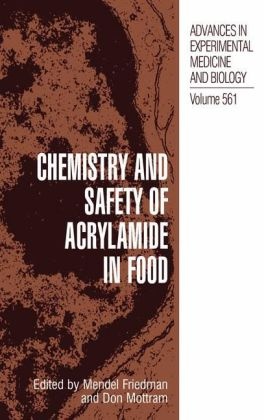Read more
Reports that heat processing of foods induces the formation of acrylamide heightened interest in the chemistry, biochemistry, and safety of this compound. Acrylamide-induced neurotoxicity, reproductive toxicity, genotoxicity, and carcinogenicity are potential human health risks based on animal studies. Because exposure of humans to acrylamide can come from both external sources and the diet, there exists a need to develop a better understanding of its formation and distribution in food and its role in human health. To contribute to this effort, experts from eight countries have presented data on the chemistry, analysis, metabolism, pharmacology, and toxicology of acrylamide. Specifically covered are the following aspects: exposure from the environment and the diet; biomarkers of exposure; risk assessment; epidemiology; mechanism of formation in food; biological alkylation of amino acids, peptides, proteins, and DNA by acrylamide and its epoxide metabolite glycidamide; neurotoxicity, reproductive toxicity, and carcinogenicity; protection against adverse effects; and possible approaches to reducing levels in food. Cross-fertilization of ideas among several disciplines in which an interest in acrylamide has developed, including food science, pharmacology, toxicology, and medicine, will provide a better understanding of the chemistry and biology of acrylamide in food, and can lead to the development of food processes to decrease the acrylamide content of the diet.
List of contents
Preface.- Acrylamide In Food: The Discovery And Its Implication.- Acrylamide Neurotoxicity: Neurological, Morphological And Molecular Endpoints In Animal Models.- The Role Of Epidemiology In Understanding The Relationship Between Dietary Acryamide And Cancer Risk In Humans.- Mechanisms Of Acrylamide Induced Rodent Carcinogenesis.- Exposure To Acrylamide.- Acrylamide And Glycidamide: Approach Towards Risk Assessment Based On Biomarker Guided Dosimetry Of Genotoxic/Mutagenic Effects In Human Blood.- Pilot Study Of The Impact Of Potato Chips Consumption On Biomarkers Of Acrylamide Exposure.- LC/MS/MS Method For The Analysis Of Acrylamide And Glycidamide Hemoglobin Adducts.- Comparison Of Acrylamide Metabolism In Humans And Rodents.- Kinetic And Mechanistic Data For A Human Physiologically Based Pharmacokinetic (PBPK) Model For Acrylamide.- In Vitro Studies Of The Influence Of Certain Enzymes On The Detoxification Of Acrylamide And Glycidamide In Blood.- Biological Effects Of Maillard Products That May Affect Acrylamide Safety Food.- Acrylamide: Formation In Different Foods And Potential Strategies For Reduction.- Mechanisms Of Acrylamide Formation: Maillard-Induced Transformations Of Asparagine.- Mechanistic Pathways Of Formation Of Acrylamide From Different Amino Acids.- New Aspects On The Formation And Analysis Of Acrylamide.- Formation Of Acrylamide From Lipids.- Kinetic Models As A Route To Control Acrylamide Formation In Food.- The Effect Of Cooking On Acrylamide And Its Precursors In Potato, Wheat, And Rye.- Determination Of Acrylamide In Various Food Matrices Using A Single Extract; Evaluation Of LC And GC Mass Spectrometric Method.- Some Analytical Factors Affecting Measured Levels Of Acrylamide In Food Products.- Analysis Of Acrylamide In Food.- On Line Monitoring Of Acrylamide Formation.- Factors That Influence The Acrylamide Content Of Heated Foods.- Model Systems For Evaluating Factors Affecting Acrylamide Formation In Deep Fried Foods.- Controlling Acry
Summary
Reports that heat processing of foods induces the formation of acrylamide heightened interest in the chemistry, biochemistry, and safety of this compound. Acrylamide-induced neurotoxicity, reproductive toxicity, genotoxicity, and carcinogenicity are potential human health risks based on animal studies. Because exposure of humans to acrylamide can come from both external sources and the diet, there exists a need to develop a better understanding of its formation and distribution in food and its role in human health. To contribute to this effort, experts from eight countries have presented data on the chemistry, analysis, metabolism, pharmacology, and toxicology of acrylamide.
Specifically covered are the following aspects: exposure from the environment and the diet; biomarkers of exposure; risk assessment; epidemiology; mechanism of formation in food; biological alkylation of amino acids, peptides, proteins, and DNA by acrylamide and its epoxide metabolite glycidamide; neurotoxicity, reproductive toxicity, and carcinogenicity; protection against adverse effects; and possible approaches to reducing levels in food. Cross-fertilization of ideas among several disciplines in which an interest in acrylamide has developed, including food science, pharmacology, toxicology, and medicine, will provide a better understanding of the chemistry and biology of acrylamide in food, and can lead to the development of food processes to decrease the acrylamide content of the diet.
Additional text
From the reviews:
"Exposure of humans to acrylamide cannot only come from external sources … but also from the diet. This new aspect initiates researchers to develop a better understanding of its formation … . a Symposium … took place in Anaheim, California on March 29-31, 2004. … The Proceedings of this symposium have been published in the Series ‘Advances in Experimental Medicine and Biology’ … . this volume is recommended to all researchers and professionals in the field of food science. They must have it … ." (Advances in Food Sciences, Vol. 28 (1), 2006)

